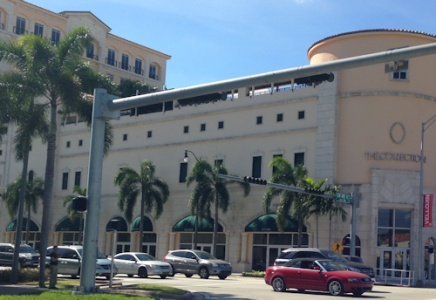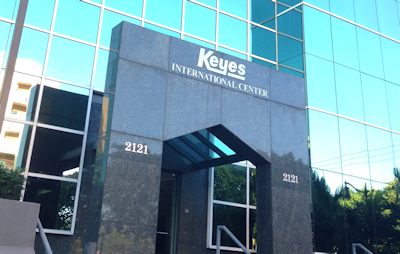Flashback Friday 1984: WTVJ Previews Then Soon to Premiere TV Show Miami Vice
As much as Miami Vice highlighted the unseemly side of the city, many believe it served to put Miami on the map. If so, it may be the foundation of Miami’s rise to global prominence, including its recent passing of Paris on it way to the rank of sixth on the Knight-Frank list of cities most important to ultra-high-net-worth individuals, and the resultant massive commercial real estate developments in the area.
Miami, One of the Most Important Cities to Ultra High Net Worth Investors
 Moves Up Ranking Of Most Important Cities For Ultra-Wealthy
Moves Up Ranking Of Most Important Cities For Ultra-Wealthy
It only takes a short walk around Miami to see that just how much this magical city attracts wealthy residents and investors from all over the globe. Miami’s luxury evolution has seen it constantly attract high net worth individuals (HNWIs) and this seems to be on the rise. Miami’s attraction of HNWIs has a direct effect on its Real Estate Investors. UK based Global Wealth Researchers Knight Frank made an attempt to answer this question in regards to Miami’s quality of life and several other indicators.
Why is Miami an Important City for HNWIs
The research by Knight Frank considered a number of factors in determining which cities play an important role for the world’s ultra rich.
• Each city’s individual Ultra High Net Worth Individuals (UHNWIs) population count – As of this writing, only about 229 UHNWIs resided in Miami. This is significantly lower than other cities like New York, San Francisco, Boston, Chicago and Houston. Miami is however on fast and gradual rise in this luxury cities list and considering it only started getting attention recently, its increase in popularity is an important factor. There is an increase in the number of Latin Americans and Europeans who are permanently establishing themselves in Miami and as a result, we can expect the number of UHNWIs to increase.
• The Cities’ Important Economic Activity and Business Links – Miami is famous for its “Fun in the sun” but has gradually transformed into a Global Business Hub promoting itself as both a business hub and holiday destination. South of New York City, Miami has the largest concentration of international banks as well as an ever increasing number of international establishments setting up their headquarters and Latin American Hubs in the city of Miami.
• Quality of Life / Lifestyle Offer – Miami earned it’s famous for one main reason, it’s lifestyle. Miami follows the “work hard, play hard” and true to this,, it is rated by Forbes as the happiest place to work in the United States. Miami has amazing nightlife, beaches, all year sunshine, amazing real estate industry and high end restaurants. Miami’s has a recently budding luxury fashion scene and many international events are now being held in Miami.
Real Estate Investments and Ultra High Net Worth Individuals
The 2014 Wealth Report, more than half of all the wealth advisors who took part in an Attitude Survey were keen to predict that UHNWI investing in Miami’s real estate would increase, and true to this, 40% of the respondents confirmed that this had actually happened. Private investors make up a quarter if all investments into commercial property. They hold the same quota for residential investments as well.
The Unites States enjoy particular interest from Chinese and South American investors. Miami in particular has sparked a lot of interest from Latin American private investors. Demand is mainly focused on the real estate industry but there is a gradual rise in interest towards commercial properties. Miami is also under the radar of wealthy Chinese investors stealing interest from Brisbane, Frankfurt, Manchester, London, Sydney and New York. Real Estate prices in Miami are lower than those in Shanghai, China by 25%. A key component of Miami is the cultural diversity and the quality of life that is on offer, and this serves as an important attraction feature for Chinese investors.
Miami is considered an affordable destination compared to other luxury destinations around the world. It also provides some of the best ocean views in the entire list of the world’s luxury destinations. Miami also has lower real estate taxes and attractive apartment and condominium prices that is making the city attractive to New Yorkers. The United states has the highest interest from wealthy private investors after Singapore and London. Miami is a key destination and as a result, benefits from Latin American and Chinese investors.
The Difference Between Usable and Rentable Square Feet
Evaluating the best deals on any commercial properties includes understanding the difference between rentable and usable square feet of the real estate property. In general, office space is advertised as rentable square feet which is higher than the actual amount of office space that the actual tenant can or will occupy.
Usable Square Feet
This is the actual area that a tenant will occupy in running his business. In the case of a partial floor lease, such space will include the office space and any private restrooms and storage space. There will be no exclusions for recessed entries, columns, or any other similar space. As an example, column space is often considered fair game when coming up with the total amount of usable square feet. In a case where a tenant will occupy an entire floor, the usable square feet will be everything that is inside the building’s boundary floor, less any stair ways and elevator shafts. Unusable spaces such as electrical and mechanical rooms, janitor closets, hallways, kitchenettes, receptions and private bathrooms are considered as usable square feet.
Rentable Square Feet
A commercial real estate building is made up so much more than cubicles and private offices. There are lobbies, meeting spaces, corridors, restrooms and stairways. These are all used by tenants and landlords will normally charge for their use. Rentable square feet therefore refers to the total amount of usable square feet as well as the pro-rata share of the common areas in the building. Pro-rate basically means that tenants will pay a proportionate amount to the amount of space they lease/occupy in the building.
Load Factor
Landlords use a load factor in order to calculate the total amount of rentable square feet. Load factor can sometimes be referred to as an add-on factor or common area factor. Load factor is a percentage that is based on the building’s common areas. For example, if a building has a total of 10,000 square feet, and of these, only 8,000 usable square feet, then this means that 2,000 sq. ft is reserved for common areas and the load factor would therefore be 1.25. (load factor = rentable square feet / usable square feet)
The load factor is calculated for each individual tenant to come up with an appropriate total rentable square feet value. (i.e total rentable square feet = load factor * total usable square feet)
This formula is important in determining the best ideal office space for a company. Buildings with a lower load factor can save a company a lot of money, but on the other hand, a company may decide to incur the expenses associated with a large and fancy lobby area and kitchenette. Knowledge of a building’s load factor allows tenants to make intelligent decisions about the value of a building and their investment. Load factor is normally represented as a percentage.
Building Owners and Managers Association International (BOMA)
Most landlords and lease agreements use BOMA standards when measuring buildings. Leases should mention whether the buddings measurements were taken according to the Building Owners and Managers Association Standards. It is advisable for tenants to hire an independent professional to verify any given measurements . As expected errors do occur and they can end up costing you a lot of money during the tenure of a lease agreement.
The Different Types of Commercial Real Estate Leases
Commercial real estate leases are categorized according to two different rent calculation methods. These are “gross” and “net”. As a consequence of this categorization, there are three different types of commercial real estate leases. Gross lease basically implies that a tenant pays the landlord one lump sum amount for rent, and the landlord in turn pays for his expenses. On the other hand, net lease demands a smaller base amount but the tenant is responsible for paying other expenses that may be incurred during the lease tenure. The third type of commercial real estate lease is the modified gross lease which is a combination of the two different types of leases we have mentioned above. The terms of commercial real estate leases will differ from one building to another but this basic overview will help you find the best possible deal for your business.
Full Service Lease or Gross Lease
In a full service lease, the rent amount is an all-inclusive fee and the tenant does not incur any additional fees associated with the commercial property they are leasing. A full service lease is sometimes referred to as a gross lease. The landlord remains responsible for paying most or all expenses including insurance, taxes, and maintenance paid out of the rent received from the tenants. Janitory services and utility fees are included in one easy rent payment.
While negotiating a gross lease, a tenant should be keen to ask which additional janitorial services are included and how often these services will be provided. It is important to note that sometimes a tenant can be charged any extra utility consumption that is considered to be above the building’s standards. In such a case, if the tenant is a high consumer of any utility services such as electricity and water, this should be clarified in the lease agreement. The tenant is still responsible for his taxes and property insurance.
This type of lease is beneficiary to the tenant as it is hustle free to the tenant who can forecast his rent expenses without having to worry about additional charges that may be incurred. The tenant can concentrate on his business as the landlord remains responsible for the building.
Net Lease
In this type of lease, the tenant will be charged a lower base rent by the landlord for the commercial space being rented as well as any additional costs that are associated operations, use or operations that the landlord will pay. Such additional expenses can include property insurance, real estate taxes, common area maintenance taxes, acronymed known as CAMS. These include property management fees, janitorial services, water, sewer, trash collection, parking lots, landscaping, fire sprinklers as well as any common shared areas or services.
There are 4 types of Net leases, these are;
1. Single Net Lease
2. Double Net Lease
3. Triple Net Lease
4. Absolute Triple Net Lease
Single Net Lease: Also known as N lease, the tenant is responsible for paying the base rent and additional pro-rata share of property tax that the building accrues during the tenure of his lease. This amount is dictated by the total amount of building space that is leased by the tenant. The tenant pays additional janitorial and utility service fees.
Double Net Lease: The NN Lease gives the tenant responsibility of paying the base rent and a pro-rate share of property insurance and property taxes. The building’s landlord is in charge of covering all common area maintenance fees and any expenses associated with structural repairs. The tenant however remains responsible for utility expenses and janitorial fees.
Triple Net Lease: The NNN Lease is the most common type of commercial real estate property lease. The tenant pays for all the three net costs. These are insurance, CAMS and property taxes on top of the monthly base rent. Common area utility expenses are usually added onto the total amount payable by the tenant as well as any additional insurance, tax, utility and janitorial services.
The cost estimates are charged to the tenant based on their pro-rate or proportional share. The triple net lease is considered more landlord friendly and tenants are always advised to carefully review the terms of the NNN lease and try to negotiate caps on the amounts that can be raised on an annual basis. The NNN lease is also prone to fluctuating operating expenses that make it quite difficult to predict the business’ expenses.
However, there are some tenant benefits that are associated with this type of lease. One such benefit is transparency since tenants can easily account for what they are paying for. The tenant is therefore able to save on his expenses, a scenario which the landlord isn’t likely to consider undertaking. A triple net lease is also potentially lower that a gross lease as a higher level of responsibility is passed on to the tenant.
Absolute Triple Net Lease: This is a less common type of commercial real estate lease that is quite rigid and more binding that a normal NNN lease. The tenant is responsible for all risks and costs associated with the building during the tenure of his lease agreement. Costs associated with natural disasters, and rent costs for a condemned building are still the responsibility of the tenant.
Modified Gross Lease
The gross lease is considered tenant friendly while the net lease, on the other hand, is more landlord friendly. The modified gross lease is a compromise between these two types of leases. The modified gross lease (alternatively referred to as the modified net lease) is similar to the gross lease in that the tenant pays a lumpsum rent amount that can optionally include any or all of the CAMS, insurance and net property taxes. Janitorial services and utility fees will often be excluded from the rent agreement and the landlord and tenants can negotiate which “nets” will be included in the base monthly rent.
A modified gross lease is popular among tenants since it offers flexibility that will automatically translate into an easier lease agreement. As opposed to the NNN lease, the lease rate does not change for a modified gross lease even if CAM charges, taxes and insurance costs increase. However, if these costs decrease, the savings are passed on to the landlord. Electricity and janitorial services are not covered and as a result, tenants are better placed to control their recurrent expenses.
Summary of Commercial Real Estate Leases
When evaluating your options for commercial property business or office space, it is extremely important to compare your available lease options keeping a keen eye on all expenses and not just the available base rental rates. NNN base rental rates are usually lower but they incur additional expenses to gt the actual monthly payable rent rate.
Rental rates associated with comparable commercial properties tend to even out because of market forces irregardless of the type of lease. Office space in the same area will attract roughly the same amount irrespective of the type of lease agreement. One of the most important rule of commercial real estate leases for the tenant to carefully read the lease agreement and seek clarification on exactly what expenses the tenant will be responsible for. Clarification should also be sought on caps and any additional charges that can be incurred by the tenant.










